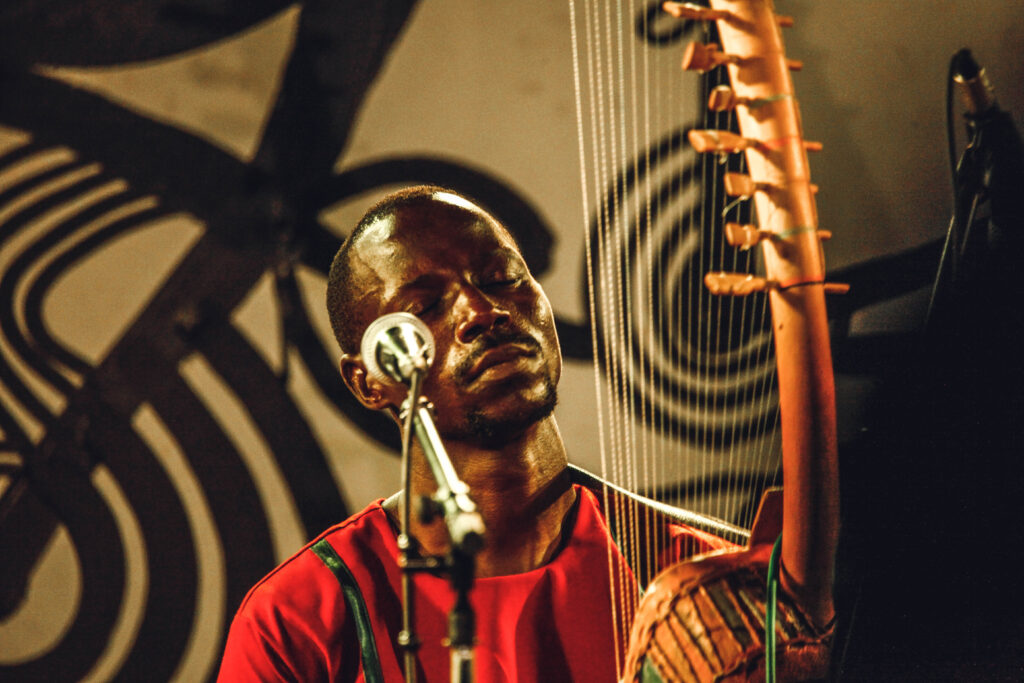By: Bill Dan Arnold Borodi
An enchanted audience was hooked to Charles Obina’s rhythms during the Annual Career day Exhibition of the UCU School of Journalism Media and Communication.
At Nkoyooyo Hall, the sight of his uniquely designed and modernised traditional Ugandan instrument,the Adungu added to the backdrop of a riveting real life musical narrative.
Obina’s story is one of strength, talent, and perseverance. Born and raised in Northern Uganda’s Agago District, his journey from the wartime atrocities of the Acholi sub-region to the international stage has been astonishing.
Despite his achievements, the 32 year old has encountered tough life struggles. In the early 2000s, he had a saddening and ugly encounter with the Lord’s resistance Army (LRA) an ordeal which greatly impacted his life . On October 22, 2002, they raided his village capturing every male , including his father, relatives and community members . “28 people were captured , killed , beheaded and cooked in a pot,later on , the surviving abductees were forced to eat the meat” a sad voiced Obina narrates.This attack is popularly known around the world as the Omot Massacre allegedly commanded by Okot Ngwinya Aye Rwota from Sinia Brigade of the LRA.
This catastrophic incident forced Obina and the remnants of his family into an Internally Displaced Persons (IDP) camp, where they battled life and death daily . A gifted musician , music became Obina’s solace during these dark times.
Obina recalls that his school was disrupted but he later on joined Patong primary school where he actively took part in music festivals using the “Adungu”, an instrument he had learnt to play well.
He recalls that music festivals were a big thing during that time and he competed at the national level in Kampala where his school won in 2005. It was a showcase opportunity that led to his escape from the war-torn region when national cultural troupes spotted his talent.
He joined the Crane Performers Culture Troupe which supported his education through secondary school at Lubiri Secondary School allowing him to continue honing his musical abilities.
In 2018, Obina enrolled at the Africa Institute of Music in Kampala where he earned a diploma specialising in the guitar .This education helped him blend traditional and Western music, creating a unique fusion that resonates with diverse audiences.
Obina improved the “Adungu” by expanding the number of strings from 10 to 22. This modernisation increased its adaptability in aiding his solo career and he received recognition for his performance at the Bayimba International Arts Festival.
Obina’s music is more than entertainment; it’s a tool for healing and advocacy. His songs address issues like climate change, girl child empowerment, and social transformation drawn from his personal experiences and community struggles.
He was greatly inspired by the late Geoffrey Oryema, who shared a similar past and musical career.
Geoffrey,the son to Erinayo Oryema a former Inspector General of Police (IGP) during Obote 1 and a minister in President Idi Amin ’s government was allegedly murdered by Amin , forcing his family to flee into exile. Geoffrey Oryema found asylum in France and became one of Uganda’s outstanding musicians on the international scene.
Charles Obina is one of the children seen in the Oscar nominated War Dance documentary movie directed by Sean Fine and Andrea Nix Fine , a touching story of talented children living in a war zone and using music as a tool to deal with the trauma. The film showcases the triumph of the human spirit and has won several International awards .


